
Theobroma is a genus of flowering plants in the mallow family, Malvaceae, that is sometimes classified as a member of Sterculiaceae. It contains roughly 20 species of small understory trees native to the tropical forests of Central and South America.

Plusiinae is a smallish subfamily of the moth family Noctuidae. As the Noctuidae appear to be a paraphyletic assemblage, the Plusiinae may eventually be raised to family status.

Panchrysia is a genus of moths of the family Noctuidae.

Autographa aemula is a moth of the family Noctuidae. It is found in mountainous areas, more specifically in the Alps, Southern France, Northeast Turkey and the Caucasus.
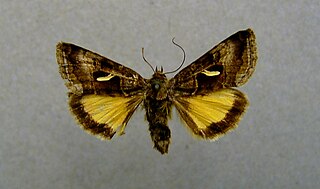
Syngrapha hochenwarthi is a moth of the family Noctuidae. It is found in the Alps, the mountainous areas of Northern Norway and Finland, the Ural Mountains, the Balkan, the Caucasus and the Altai Mountains.

Phlogophora scita is a moth of the family Noctuidae. It is found in most countries of continental Europe, from France to Belarus, Ukraine and Turkey, and from Germany and Poland to Italy and Greece In the Alps it is found up to heights of 1,600 meters.

Euxoa recussa is a moth of the family Noctuidae. The nominate form is found in mountainous areas in Southern Europe as well as the Alps. Euxoa recussa tetrastigma is found Northern Europe, east to Russia, Western Siberia, the Altai Mountains and Amur.

Simyra nervosa is a moth of the family Noctuidae. In Europe, it is found from France, east through north and north-eastern Germany to Poland. South of the Alps it is found from northern Italy, through the Balkan countries to Greece. There is an isolated population in Sicily. In Asia, it is found in Anatolia, the Caucasus, Iran, Afghanistan, Siberia, Tibet, Mongolia and China.

Xestia rhaetica is a moth of the family Noctuidae. It is found in northern Europe, central Fennoscandia, northern Russia and further east to Siberia. It is also present in the Tatra Mountains and the Bohemian Forest. In the Alps it is found on altitudes between 1,000 and 2,500 meters, but it is found at sea level in northern Europe. The species is also present in the Nearctic, including New York.
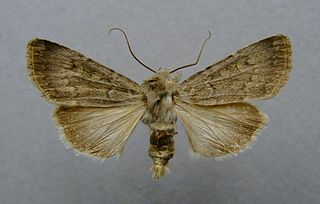
Euxoa decora is a moth of the family Noctuidae. It is found in southern and central Europe, Morocco, Algeria, the Caucasus, Armenia, Issyk-Kul, Turkey, Iran and Iraq.
Stigmella filipendulae is a moth of the family Nepticulidae. It is found from Fennoscandia to the Alps and the Carpathians, and from Ireland to Poland. There is a disjunct population in Greece.
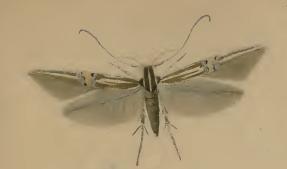
Cosmopterix lienigiella is a moth of the family Cosmopterigidae. It is found from Fennoscandia to Spain, the Alps and Greece and from Ireland to Ukraine. It is also present in eastern Russia and Japan. It is the type species of the genus Cosmopterix.
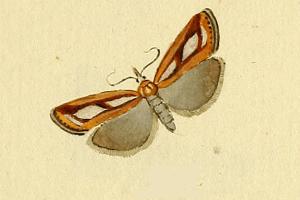
Catoptria myella is a species of moth in the family Crambidae. It is found in large parts of Europe, except Ireland, Great Britain, the Benelux, Fennoscandia, Denmark, the Baltic region, the Czech Republic, Slovakia and the Iberian Peninsula.
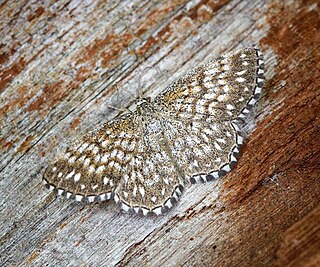
Scopula tessellaria, the dusky-brown wave, is a moth of the family Geometridae. It is found in Belgium, Luxembourg, France, Germany, Italy, Spain, Albania, former Yugoslavia, Croatia, Bulgaria, Romania, North Macedonia, Greece, Moldova, Ukraine and Russia. In the east, the range extends to the Near East and the eastern part of the Palaearctic realm.
Eupithecia spissilineata is a moth in the family Geometridae. It is found in the southern Alps of France, as well as Italy, Bosnia and Herzegovina, North Macedonia, Greece, Bulgaria, Romania and Ukraine.

Panchrysia ornata is a species of moth of the family Noctuidae. It is found from the Ural Mountains, through Siberia, Mongolia, Sikhote-Alin and the Paektu Mountains to Kamchatka and the Pacific coast. It is found up to altitudes of 2,400 meters.

Panchrysia aurea is a moth of the family Noctuidae. It is found in southern Europe and western and central Asia. The range extends from Portugal, east to Tian Shan, the Altai and the north-western Himalayas. In central Europe, it is found in the southern Alps, lower Austria and the mountains on the Balkan Peninsula.

Panchrysia dives is a moth of the family Noctuidae. It is found from the Ural, east through southern Siberia to the Pacific Ocean. The range includes Kamchatka, Sakhalin and the Kuriles.

Bryum argenteum, the silvergreen bryum moss or silvery thread moss, is a species of moss in the family Bryaceae. It is one of the most common mosses of urban areas and can be easily recognized without a microscope.
The Gallic Alps were an ancient cultural region located in the Alps and populated mainly by Gauls. The term Celtic Alps is also found in ancient Greek texts.















